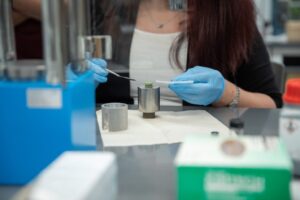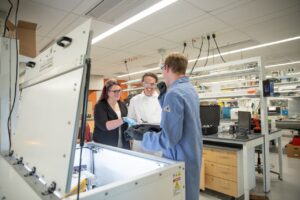Materials science research has been advancing and improving products in the world around us for decades. Traditionally, those materials are developed by tweaking what is already naturally stable.
But Virginia Tech Assistant Professor Tina Rost is flipping that research on its head.
With a nearly $800,000 National Science Foundation Faculty Early Career Development (CAREER) award, Rost will explore controlling the disorder in a relatively new class of materials called high-entropy ceramics. The goal is to build new material compositions from scratch with properties that can be carefully controlled, making them stronger, more heat resistant, and even electronically and magnetically unique.

A whole new world of high entropy
High entropy refers to the level of disorder in the mixture of multiple elements in a lattice: a 3D framework of atoms, ions, and molecules that determines a material’s properties. In a traditional ceramic, a few types of atoms are arranged in a repeating pattern or random solution, but high-entropy ceramics often mix five or more elements randomly, making them more stable as well as more easily tailored for different electrical, magnetic, and mechanical properties.
Rost helped discover this field by chance during her time as a graduate student at North Carolina State University. “Other researchers who study these high-entropy ceramics talk about how innovative it is,” she said. “But the truth is, when we first began presenting our initial findings on a particular oxide composition many researchers told me it would never amount to anything.”
The materials science and engineering faculty member didn’t let that stop her. She’s spent the last 10 years refining that work in various capacities and materials, including oxides, carbides, nitrides, and more.
“The cool thing is that now the periodic table is open to do whatever we want. It basically opened the door to a playground — a new scientific avenue of discovery.”
Why it matters
Creating unnatural combinations of atoms can unlock new performance, especially in fields such as quantum computing, aerospace, and defense. In addition, Rost’s team will use machine learning to help analyze materials to ultimately predict specific materials that match real-world needs without years of trial and error.
“Instead of taking 10 years to find a solution for a better material, machine learning–enhanced analysis can help do it in a fraction of that time,” she said.

Collaborators
- Horst Hahn, professor, materials science and engineering, University of Arizona
- Tianshu Li, professor, civil and environmental engineering, The George Washington University
- Nancy Ross, professor, geosciences, Virginia Tech
- Joshua Wright, research assistant professor, Illinois Institute of Technology
“Over the years, I have followed Christina’s exceptional career and was happy to establish a collaboration with her after we met for the first time at a high-entropy materials conference,” said Hahn, professor and special advisor to the senior vice president for research and partnerships at the University of Arizona. “Collaborations with other institutions are extremely important for the advancement of science, and I am looking forward to seeing how this work will improve our understanding of these compositionally complex materials.”
The research team will also be partnering with Christine Burgoyne and Michelle Czamanske from the Department of Materials Science and Engineering to spearhead the educational components of the project. In collaboration with the Center for Educational Networks and Impacts and University Libraries, the team will revamp the Journal for Undergraduate Materials Research, develop enhanced programming for the materials science and engineering graduate program, and provide hands-on learning opportunities for K-12 students in Appalachia, with the goal of increasing STEM literacy via the Virginia Tech Science Festival.
“I get to continue work that I deeply care about and bring in people at all levels of education — that’s what modern science should look like,” Rost said.
By Chelsea Seeber


